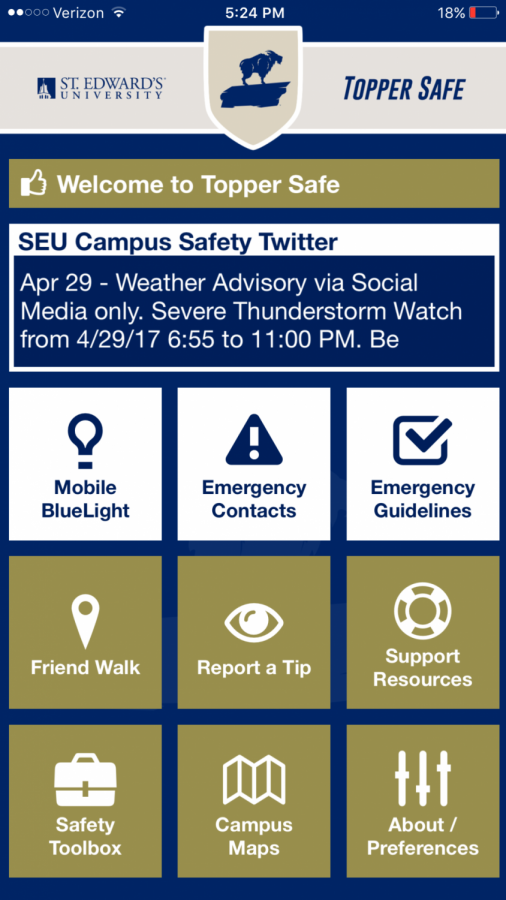New ‘Topper Safe’ app available after months of testing, feedback
St. Edward’s launched its Topper Safe app in early May. The app puts all reources and emergency information in one place for students, parents, faculty and campus visitors.
Even on a small campus like St. Edward’s University, trepidation can wash over a student walking from the library to their residence hall at night.
To ease that worry, new safety app, called Topper Safe, has launched at the university and is free for students, faculty, visitors and students’ families.
Available for download the first week of May, Topper Safe is the university’s official personal safety mobile app. For nearly nine months, research was gathered, a developer hired and user groups picked to help narrow down what information should be included in the app, said Scott Burnotes, assistant vice president of Campus Safety.
The app had input from numerous departments on campus, including the Student Government Association, Division of Student Affairs and Office of Information Technology.
Former SGA Vice President Carlos Martinez was part of a group of students that gave feedback and suggestions for the app before it launched. The app fills a void on campus, Martinez said.
“It shows the student body that Campus Safety and the university is listening,” Martinez said.
The Office of Campus Safety and Burnotes’ position were created in 2016, bringing together law enforcement and emergency preparedness to inform and protect the campus.
“When I came here, this [safety app] was one of the most important initiatives that I was wanting to implement,” Burnotes said.
The app is customized for the St. Edward’s campus and owned by the university. The hope is more students will download and use the app without having to enter information or register, Burnotes said.
“The more steps that we were seeing, based off feedback from other institutions that we talked to, the more steps, the more unlikely a student or employee is to actually download and use the app,” Burnotes said.
There are nine main features within the app that offer information useful in an emergency situation, reporting anonymous tips and resources available to community members. In addition, if a user enables location services while using the app and calls for help, UPD will be able to see the person’s location. Previously, UPD could not locate where a call was coming from on campus.
One feature is Friend Walk. It allows users to share their location in real time with family or friends, so they can be tracked as they walk across campus. It can also be used off campus.
Another feature, Support Resources, lists the most common resources available, in one location, to help students and university employees recover during and after a time of crisis.
Other parts include interactive maps of campus, emergency guidelines with best practices on what to do during a crisis and Emergency Contacts, with the phone numbers to important offices on campus, including UPD, Dean of Students and the Health & Counseling Center.
“How do we just engage the community more,” Burnotes said. “The goal here is to build a culture of preparedness and safety, and also give students, faculty and staff resources that you can take into your own hands.”
The app is available in the Apple App Store and Google Play. The university plans to promote the app to incoming students over the summer during orientation sessions and the campus as a whole for the fall semester.







